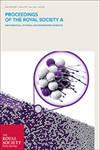受列奥纳多的三角形砌体结构启发,柔性整体分段梁的剪切和弯曲变形
IF 3
3区 综合性期刊
Q1 MULTIDISCIPLINARY SCIENCES
Proceedings of the Royal Society A: Mathematical, Physical and Engineering Sciences
Pub Date : 2023-11-01
DOI:10.1098/rspa.2023.0453
引用次数: 1
摘要
在《大西洋抄本》的XCI版中,列奥纳多·达·芬奇展示了一个由倒三角形状的分段组成的巧妙的砖石结构。它们通过接触在链中组装以获得门楣或千斤顶拱,在那里它们被末端约束的推力压在一起。从列奥纳多的草图中得到灵感,我们展示了,通过弹性腱连接成对的部分,这个系统代表了一种新型的柔性整体梁。在经典柔性整体中,节段的接触面是弯曲的共轭轮廓,沿着适当设计的节距线施加纯滚动运动:随后的肌腱伸长决定了本构响应作为节段相对旋转的函数。在这里,接触是通过平面进行的,因此运动学除了相对旋转之外,还具有分段剪切的特征。对该系统进行了理论分析,并推导出了随着段长变小的连续统模型。与三维打印原型的实验比较证实了理论发现,并强调了旋转变形和滑动变形之间可能存在的竞争。除了历史价值,这种类型的建筑可以用于创新结构或超材料。本文章由计算机程序翻译,如有差异,请以英文原文为准。
Shear and flexural deformations in flextegrity segmental beams inspired by Leonardo’s triangular masonry construction
In Tabula XCI verso of Codex Atlanticus, Leonardo da Vinci presents an ingenious masonry structure composed of segments in the shape of inverted triangles. These are assembled by contact in a chain to obtain a lintel or jack arch, where they are pressed together by the thrust of the end constraints. Drawing inspiration from Leonardo’s sketches, we show that, by connecting the segments in pair through elastic tendons, this system represents a new type of flextegrity beam. In a classical flextegrity, the contact surfaces of the segments are curved conjugate profiles, imposing a pure rolling motion along properly designed pitch lines: the consequent elongation of the tendon dictates the constitutive response as a function of the relative rotation of the segments. Here, the contact is through plane surfaces, so that the kinematics, besides the relative rotation, is characterized by segmental shearing. This system is theoretically analysed and a continuum model is derived as the length of the segments becomes small. Comparisons with experiments on three-dimensional-printed prototypes confirm the theoretical findings and highlight the possible competition between rotational and sliding types of deformation. Apart from the historical value, this type of construction can be used in innovative structures or metamaterials.
求助全文
通过发布文献求助,成功后即可免费获取论文全文。
去求助
来源期刊
CiteScore
6.40
自引率
5.70%
发文量
227
审稿时长
3.0 months
期刊介绍:
Proceedings A has an illustrious history of publishing pioneering and influential research articles across the entire range of the physical and mathematical sciences. These have included Maxwell"s electromagnetic theory, the Braggs" first account of X-ray crystallography, Dirac"s relativistic theory of the electron, and Watson and Crick"s detailed description of the structure of DNA.

 求助内容:
求助内容: 应助结果提醒方式:
应助结果提醒方式:


